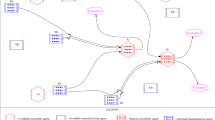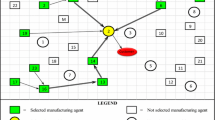Abstract
Virtual computer-integrated manufacturing (VCIM) is a global integrated manufacturing system, capable of exploiting the locally as well as globally distributed resources. Production scheduling is one of the critical factors to the success of VCIM systems. In this paper, a VCIM integrated production scheduling model is proposed which allows optimisation of the production scheduling of simultaneous multiple product orders. In the model, two major issues of the production scheduling, namely agent selection and collaborative shipment scheduling for multiple product orders, are fully integrated together to take advantage of the shipment collaboration. The effectiveness of the proposed model is demonstrated by a comprehensive case study with the aid of Genetic Algorithm solver in Matlab. The achievements of this study can serve as the fundamental steps towards the developing a decision support system capable of helping decision makers to operate VCIM systems more effectively.




Similar content being viewed by others
References
Asawasakulsorn A (2009) Transportation collaboration: partner selection criteria and IOS design issues for supporting trust. Int J Bus Inf 4(2):199–220
Chan FTS, Zhang T (2011) The impact of collaborative transportation management on supply chain performance: a simulation approach. Expert Syst Appl 38(3):2319–2329
Dai B, Chen H (2009) Mathematical model and solution approach for collaborative logistics in less than truckload (LTL) transportation. In: International conference on computers & industrial engineering, Troyes, France, pp 767–772
Dao SD, Marian R (2013) Genetic algorithms for integrated optimisation of precedence-constrained production sequencing and scheduling. In: Ao S-I, Gelman L (eds) Electrical engineering intelligent systems. Springer, New York, pp 65–80
Dao SD, Abhary K, Marian R (2012) Optimisation of resource scheduling in VCIM systems using genetic algorithm. Int J Adv Res Artif Intell 1(8):49–56
Dao SD, Abhary K, Marian R (2014) Optimisation of partner selection and collaborative transportation scheduling in virtual enterprises using GA. Expert Syst Appl 41(15):6701–6717
Dao SD, Abhary K, Marian R (2016a) An innovative model for resource scheduling in VCIM systems. Oper Res Int J. doi:10.1007/s12351-016-0252-y
Dao SD, Abhary K, Marian R (2016b) A stochastic production scheduling model for VCIM systems. Intell Ind Syst 2(1):85–101
Ergun Ö, Kuyzu G, Savelsbergh M (2007) Shipper collaboration. Comput Oper Res 34(6):1551–1560
Ju S, Shenoi RA, Jiang D, Sobey AJ (2013) Multi-parameter optimization of lightweight composite triangular truss structure based on response surface methodology. Compos Struct 97:107–116
Lair NAM (2008) An integrated model for optimising manufacturing and distribution network scheduling. Ph.D. thesis, School of Advance Manufacturing and Mechanical Engineering, University of South Australia
Nagalingam SV, Lin GCI, Wang D (2007) Resource scheduling for a virtual CIM system. In: Wang L, Shen W (eds) Process planning and scheduling for distributed manufacturing. Springer, London, pp 269–294
Ozener OO (2008) Collaboration in transportation. Ph.D. thesis, Georgia Institute of Technology, Atlanta
Wang D (2007) The development of an agent-based architecture for virtual CIM. Ph.D. thesis, University of South Australia, Adelaide
Wang D, Nagalingam SV, Lin GCI (2003) Development of a virtual CIM system using agent-based approach. In: The 7th international conference on mechatronics technology, Taipei, Taiwan, pp 445–450
Wang D, Nagalingam SV, Lin GCI (2004a) A parallel processing multi-agent architecture for virtual CIM system. In: The 14th international conference on flexible automation and intelligent manufacturing, Toronto, Canada, pp 1–9
Wang D, Nagalingam SV, Lin GCI (2004b) Development of a parallel processing multi-agent architecture for a virtual CIM system. Int J Prod Res 42(17):3765–3785
Wang D, Nagalingam SV, Lin GCI (2004c) Production and logistic planning towards agent-based virtual CIM system in an SME network. In: Eighth international conference on manufacturing and management, Queensland, Australia, pp 1–8
Wang D, Nagalingam SV, Lin GCI (2005) A novel multi-agent architecture for a virtual CIM system. Int J Agile Manuf 8(1):69–81
Wang D, Nagalingam SV, Lin GCI (2007) Development of an agent-based virtual CIM architecture for small to medium manufacturers. Robot Comput-Integr Manuf 23(1):1–16
Wu W, Lai S-Y, Jang M-F, Chou Y-S (2013) Optimal adaptive control schemes for PHB production in fed-batch fermentation of Ralstonia eutropha. J Process Control 23(8):1159–1168
Zhou N, Xing K, Nagalingam SV (2010a) An agent-based cross-enterprise resource planning for small and medium enterprises. IAENG Int J Comput Sci 37(3):1–7
Zhou N, Xing K, Nagalingam SV, Lin GCI (2010) Development of an agent based VCIM resource scheduling process for small and medium enterprises. In: International multiconference of engineers and computer scientists, Hong Kong, pp 39–44
Zhou N, Nagalingam SV, Xing K, Lin GCI (2011) Inside virtual CIM: multi-agent based resource integration for small to medium sized manufacturing enterprises. In: Ao S-I, Castillo O, Huang X (eds) Intelligent control and computer engineering, vol 70. Springer, Netherlands, pp 163–175
Zhu H, Wang Y, Wang K, Chen Y (2011) Particle swarm optimization (PSO) for the constrained portfolio optimization problem. Expert Syst Appl 38(8):10161–10169
Acknowledgments
The first author is grateful to Australian Government for sponsoring his Ph.D. study at University of South Australia, Australia in form of Endeavour Award.
Author information
Authors and Affiliations
Corresponding author
Rights and permissions
About this article
Cite this article
Dao, S.D., Abhary, K. & Marian, R. An integrated production scheduling model for multi-product orders in VCIM systems. Int J Syst Assur Eng Manag 8, 12–27 (2017). https://doi.org/10.1007/s13198-016-0504-5
Received:
Accepted:
Published:
Issue Date:
DOI: https://doi.org/10.1007/s13198-016-0504-5




